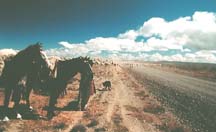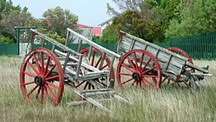Working Conditions on the Patagonian Pampa [Quotation]
Back to our early travellers! After stocking up on fuel, provisions
and fresh water, the steamship sailed southwards along the Argentine coast
berthing at various ports en route. It had been pre-arranged by letter that
representatives of the sheep companies were to meet the new recruits at the
appropriate port of arrival. From there they were to travel inland to the
 estancia's
headquarters -- sometimes two days' riding away, or more, in a horse drawn
wagon. After resting at the farm-manager's house for a day or two, they were
given their instructions, a troop of horses, sheepdogs, a gun, a poncho and
a blanket to keep them warm and another shepherd on horseback was assigned
the task of leading the new recruit to his shanty very many miles away 'out
on camp'. This was to be their very lonely abode on the pampa, fifteen or
twenty miles distant from their nearest neighbour. The shanty was a small,
two-roomed corrugated iron shack with a small wood-burning stove and other
basic requirements such as a bed, table and chairs. There was a kennel outside
for the dogs and a shelter for the horse.
estancia's
headquarters -- sometimes two days' riding away, or more, in a horse drawn
wagon. After resting at the farm-manager's house for a day or two, they were
given their instructions, a troop of horses, sheepdogs, a gun, a poncho and
a blanket to keep them warm and another shepherd on horseback was assigned
the task of leading the new recruit to his shanty very many miles away 'out
on camp'. This was to be their very lonely abode on the pampa, fifteen or
twenty miles distant from their nearest neighbour. The shanty was a small,
two-roomed corrugated iron shack with a small wood-burning stove and other
basic requirements such as a bed, table and chairs. There was a kennel outside
for the dogs and a shelter for the horse.
That they had to be resourceful and inventive from now on goes
without saying, and in heavy winter snowfalls prevalent on the pampa in those
days, life in this lonely outpost was hard by any standard. Each shepherd
was responsible for several thousand sheep and this required riding extensively
over their 'track' each day tending to their flock and deterring predators
such as puma and fox. At dipping and shearing time all the sheep were gathered
in to the estancia headquarters and this was looked forward to as it was an
opportunity to meet up with the other lads and enjoy the exchange of news ...
...
Before the advent of the motor vehicle on the pampa, after the First World War, life was very hard for shepherd and farmer and in order to ship their wool, they had to convey it by wagon to the nearest point on the coast. The wagon was usually drawn by a team of 12-20 horses, sometimes the team also consisting of bullocks and mules. This journey to the coast could take from 6-8 days and often on arrival at the port no handling facilities were available. They had to wait until this was organized and then began the hard work of loading the barges. These barges ferried the wool bales to the waiting cargo ships anchored off shore and this could be hazardous work at times ...